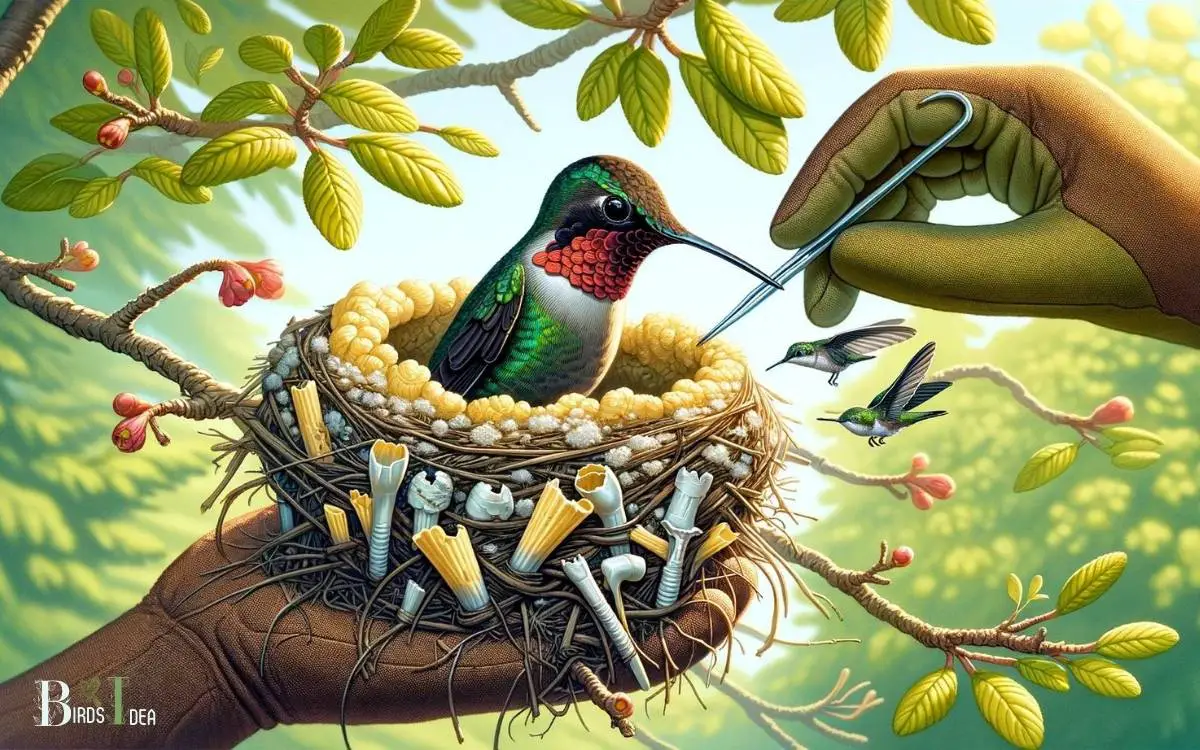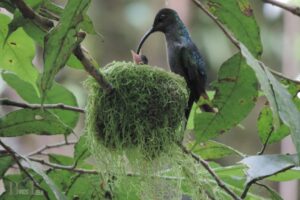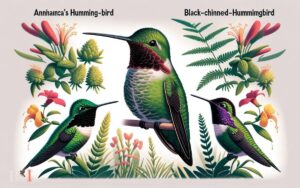Do Ruby-throated Hummingbirds Reuse Their Nests? Explain!
Ruby-throated Hummingbirds may reuse the structural foundation of old nests, but they typically renovate and rebuild on them each year rather than using the exact same nest as before.
Ruby-throated Hummingbirds, known scientifically as Archilochus colubris, have intriguing nesting behaviors.
While they do not often reuse a nest without modifications, they may return to a previous nesting site and refurbish it for the new breeding season.
The female is responsible for the nest construction, which is an intricate process that involves:
Here are a few key points about their nesting habits:
- Nests from previous seasons may serve as a base for new construction.
- Females might build a new nest atop the remains of an old one.
- Refurbishing includes adding new layers of materials and ensuring the structure’s stability.

Key Takeaway
The Nesting Behavior of Ruby-throated Hummingbirds
The nesting behavior of the Ruby-throated Hummingbirds involves the construction and maintenance of small, cup-shaped nests.
These nests are typically built using plant material, spider silk, and other natural elements, and are lined with soft materials like plant down and feathers for insulation and comfort.
The female hummingbirds are solely responsible for nest construction, a process that can take anywhere from 6 to 10 days.
Once the nest is completed, the female lays her eggs and incubates them for about 12-14 days. After hatching, the female continues to care for the young birds until they fledge.
Understanding the intricacies of this nesting behavior is crucial in exploring the factors influencing nest reuse, which will be discussed in the following section.
Factors Influencing Nest Reuse
One significant factor influencing nest reuse by Ruby-throated Hummingbirds is the availability of suitable nesting materials in the vicinity.
The following factors also play a crucial role in influencing nest reuse:
- Site Quality: Hummingbirds tend to reuse nests in areas with suitable microclimates, such as protection from strong winds and excessive sunlight.
- Predator Presence: The absence of significant nest predators in the vicinity increases the likelihood of nest reuse.
- Resource Availability: Access to food sources and nectar-producing flowers nearby may influence the decision to reuse a nest.
- Previous Success: If a particular nesting site has been successful in the past, hummingbirds are more likely to reuse it.
Considering these factors provides insights into the complex decision-making process of nest reuse by Ruby-throated Hummingbirds and sheds light on their nesting behavior.
Nest Construction and Location Preferences
A key aspect of Ruby-throated Hummingbird behavior is their selective choice of nest construction and location preferences.
These tiny birds meticulously construct their nests using plant material, spider silk, and other natural fibers, weaving them into small, cup-shaped structures.
The location of the nest is also crucial, as it provides protection from predators and the elements while offering easy access to food sources.
Here is a summary of their nest construction and location preferences:
| Aspect | Description |
|---|---|
| Nest Material | Plant material, spider silk, natural fibers |
| Nest Shape | Small, cup-shaped structures |
| Nest Location | Protected from predators and elements, near food sources |
Breeding Season Nesting Patterns
During the breeding season, Ruby-throated Hummingbirds exhibit interesting nesting patterns that raise questions about their nest reuse behavior.
Understanding whether these birds reuse their nests and the potential environmental benefits of such behavior can provide valuable insights into their breeding ecology.
Exploring the reasons behind their nesting patterns can shed light on the adaptive strategies of these remarkable avian species.
Nest Reuse Behavior
The Ruby-throated Hummingbird’s nest reuse behavior during the breeding season demonstrates a remarkable efficiency in nesting patterns.
This behavior is characterized by:
- Conservation of Energy: Reusing existing nests reduces the energy and time required to build new ones, allowing the hummingbirds to allocate resources more efficiently.
- Enhanced Nest Quality: As the birds repair and refurbish old nests, they improve structural integrity and insulation, providing a better environment for nurturing their young.
- Optimized Location: Reusing nests in familiar and successful locations increases breeding success by leveraging the knowledge of suitable nesting sites.
- Adaptation to Environmental Changes: Nest reuse allows for adaptation to fluctuating environmental conditions, as the birds can quickly modify existing nests to accommodate varying weather patterns.
This efficient nesting behavior showcases the hummingbird’s adaptability and resourcefulness.
Environmental Benefits of Reuse?
Nest reuse by Ruby-throated Hummingbirds during the breeding season presents several environmental benefits, particularly in optimizing resource utilization and minimizing habitat disturbance.
By reusing existing nests, hummingbirds reduce the need for additional energy and materials required to construct new nests. This conservation of resources is especially important during the breeding season when energy demands are high.
Additionally, nest reuse minimizes habitat disturbance as it reduces the need for constant nest building, which can disrupt the surrounding environment. This can be particularly beneficial in areas where habitat loss and fragmentation are significant concerns.
Furthermore, the availability of suitable nesting sites can be limited, making nest reuse a practical and sustainable strategy for Ruby-throated Hummingbirds to successfully raise their young while minimizing their environmental impact.
Nest Maintenance and Repair
Hummingbirds diligently maintain and repair their nests to ensure a safe and secure environment for their offspring. This behavior is crucial for the survival of the young hummingbirds.
The nest maintenance and repair activities include:
- Adding Insulation: Hummingbirds frequently add soft plant materials, such as dandelion or thistle down, to the nest to provide insulation and regulate temperature.
- Replacing Damaged Material: Any wear and tear or damage to the nest is promptly repaired by the hummingbirds using spider silk, plant fibers, and other flexible materials.
- Removing Waste: Hummingbirds clean their nests by removing any waste or debris to maintain a hygienic environment for their hatchlings.
- Expanding the Nest: As the chicks grow, the parent hummingbirds expand the nest to accommodate the increasing size of the offspring.
Nest Reuse Among Female Hummingbirds
Female hummingbirds exhibit a natural inclination towards reusing their nests, a behavior that reflects their resourcefulness and adaptability in optimizing their reproductive efforts.
This tendency to reuse nests can be attributed to the energy and time investment required for nest construction.
By reusing nests, female hummingbirds conserve valuable resources and can focus their efforts on other aspects of reproduction.
Additionally, nest reuse may provide a strategic advantage by allowing females to familiarize themselves with the nesting site and assess its suitability before the next breeding season.
The table below illustrates the benefits and considerations associated with nest reuse among female hummingbirds.
| Benefits | Considerations |
|---|---|
| Conservation of resources | Nest deterioration |
| Familiarity with site | Potential parasite buildup |
| Time and energy savings | Predation risk |
Male Hummingbird Nesting Roles
The role of male hummingbirds in nest building and maintenance is an essential aspect of their breeding behavior.
Understanding the specific behaviors and contributions of male hummingbirds to the nesting process can provide valuable insights into their reproductive strategies.
By examining the male hummingbird’s role in nest construction and maintenance, we can gain a more comprehensive understanding of their nesting ecology and the factors influencing their reproductive success.
Male Nest Building
Male hummingbirds play a significant role in nest building during the breeding season. They are responsible for constructing the nest using various materials such as plant fibers, moss, and spider silk.
The male hummingbird’s nest building process involves the following key activities:
- Site Selection: The male identifies and selects a suitable location for the nest, often in a well-concealed area to provide protection from predators.
- Collecting Nesting Materials: He gathers a variety of soft materials, including downy plant fibers and moss, to construct a cozy and insulating nest.
- Weaving and Shaping: Using his beak and feet, the male meticulously weaves and shapes the collected materials into a cup-shaped nest, ensuring it is secure and stable.
- Nest Maintenance: Throughout the breeding season, the male performs regular maintenance to ensure the nest remains sturdy and comfortable for the female and their offspring.
Nest Maintenance Behavior
During the breeding season, male Ruby-throated hummingbirds engage in regular nest maintenance to ensure the structural integrity and comfort of the nesting environment.
This behavior includes repairing any damage to the nest, adding new materials as needed, and ensuring that the nest remains a secure and suitable place for the female to lay her eggs and raise their young.
Male hummingbirds may also participate in cleaning the nest by removing any debris or waste to maintain a hygienic environment for the developing offspring.
Additionally, they may engage in territorial defense to protect the nesting site from potential threats.
By taking an active role in nest maintenance, male Ruby-throated hummingbirds contribute to the overall success of the breeding season and the health and well-being of their offspring.
Implications for Conservation and Research
Researchers must consider the potential impact of nest reuse by Ruby-throated Hummingbirds on conservation efforts and field studies.
Understanding the implications of this behavior is crucial for effective conservation and research strategies.
- Nest site conservation: Reused nests may need to be protected to ensure the hummingbirds have suitable nesting sites in subsequent seasons.
- Population monitoring: Nest reuse could affect population estimates if the same nest is counted multiple times in different seasons.
- Behavior studies: Researchers need to account for nest reuse when studying nesting behavior and success rates.
- Habitat management: Knowledge of nest reuse can inform habitat management practices to better support hummingbird populations.
Conclusion
The nesting behavior of ruby-throated hummingbirds is a fascinating and complex phenomenon that is influenced by various factors.
The reuse of nests by female hummingbirds is a remarkable display of resourcefulness and efficiency. This behavior has important implications for conservation efforts and further research into the breeding habits of these incredible birds.
Overall, the nesting behavior of ruby-throated hummingbirds is a wondrous spectacle that continues to captivate and intrigue researchers and bird enthusiasts alike.






